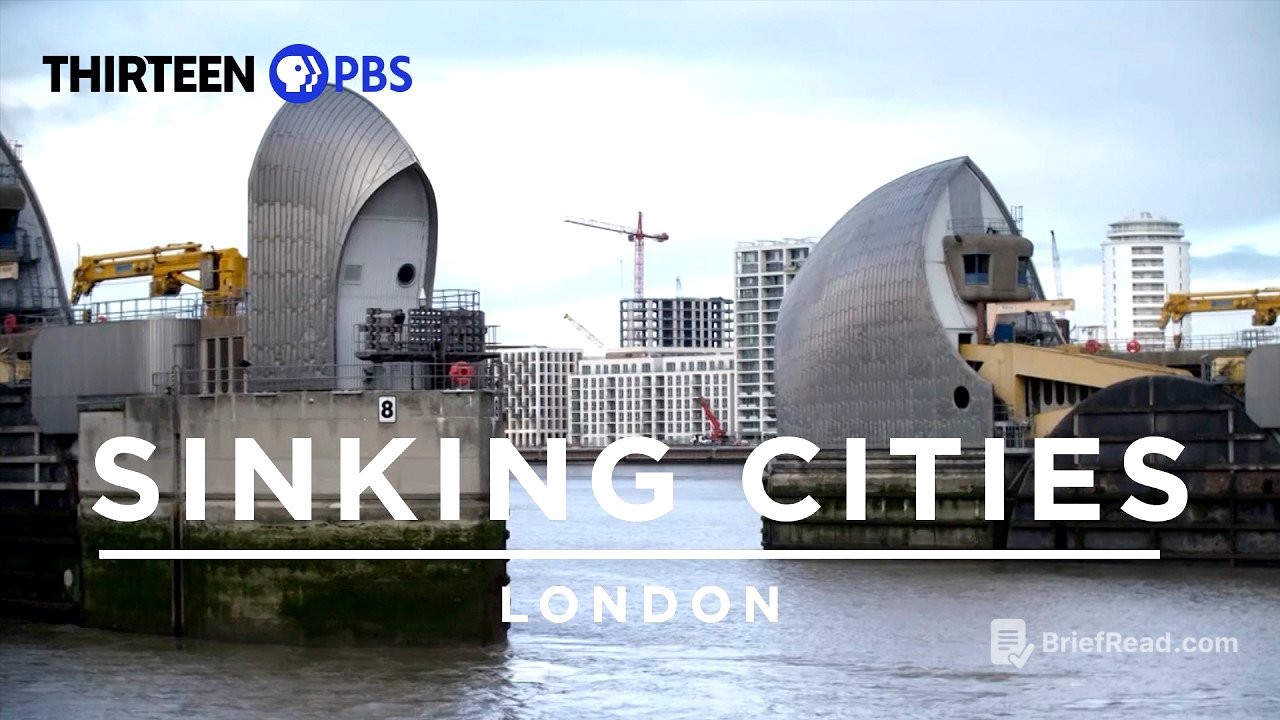TLDR;
This video explores the increasing flood risk in London due to climate change and urbanisation, and the solutions being implemented to combat it. It highlights the history of flooding in London, the role of the Thames Barrier, and the need for new strategies such as improved forecasting, sustainable drainage systems, rediscovering lost rivers, and floating architecture.
- London faces increasing flood risk from rising sea levels, increased rainfall, and urban development.
- The Thames Barrier, while effective, is under increasing strain and may need replacement.
- New solutions include better forecasting, sustainable drainage systems (SUDS), rediscovering lost rivers, and floating architecture.
Introduction [0:00]
London is facing increasing threats from water coming from all directions, a situation exacerbated by both urbanisation and climate change. The city's vulnerability to flooding is a recurring issue with historical precedents and potential future occurrences. The existing flood defences, including the Thames Barrier, are under pressure, prompting the need for innovative solutions to protect the city and its inhabitants.
Flash Flooding and Storm Surges [2:56]
Flash flooding has become a common occurrence in London, with one incident in 2007 flooding 1,400 properties. The increased urban regeneration, which has reduced open spaces, exacerbates the problem as rainwater can no longer be absorbed into the ground. London faces three main challenges: increased summertime rainfall, dense development along the Thames floodplain, and rising sea levels affecting the Thames. The Thames, while vital to London's prosperity, also poses a significant flood risk due to its connection to the North Sea. The North Sea's shallow and funnel-like shape makes it prone to storm surges, which can push water into the Thames Estuary and towards London.
London’s Historic Floods (1928 & the Unprecedented 1953 North Sea Flood) [6:55]
London has a long history of flooding, with records dating back thousands of years. In 1928, a storm surge combined with high flow on the Thames flooded central London, resulting in casualties and displacement. The term "storm surge" was coined after this event. The 1953 North Sea flood was a major wake-up call for London. The storm, combined with a rising spring tide, caused widespread inundation and significant loss of life, particularly on Canvey Island. The disaster prompted the city to take action to improve its flood defences.
Bolstering the City’s Flood Defenses: The Thames Barrier [10:09]
In response to the 1953 flood, London decided to bolster its flood defences. Options considered included doing nothing, moving London, or building a barrier. The city chose to build a barrier and invested in nearly 200 miles of embankments, gates, and barriers along the Thames and its tributaries. The Thames Barrier, a 600-yard-long floodgate completed in 1982, is the centrepiece of this system. The barrier remains open to allow boat traffic but can be closed to protect London from storm surges. Since its installation, the barrier has been used 182 times, preventing London from being flooded.
The Barrier’s Unexpected Role: Responding to the 2013 Storms [14:14]
The Thames Barrier was designed for a one-in-a-1,000-year event, providing a high level of protection. However, climate change has presented new challenges. The barrier was designed in the 1960s, before climate change was a widely recognised issue. Designers accounted for rising sea levels due to the sinking of South East England, but not in the context of accelerated climate change. In December 2013, a severe weather event tested the Thames Barrier system. Torrential rain caused unprecedented water volume in the Thames, leading to fluvial flooding. The barrier was used to manage the excess rain by closing at low tide and using the river as a reservoir. While central London was spared, areas upstream experienced severe flooding.
Urbanization’s Impact: How London’s Growth Increased Flood Risk [21:09]
London's future is uncertain as the Thames Barrier is being used more frequently than intended. Urbanisation has significantly increased flood risk. The city's population has doubled in the last 125 years, leading to denser building and paving over of green spaces. This reduces the ground's ability to absorb rainwater, increasing runoff into already strained sewer systems. Approximately 15% of Greater London is considered a floodplain, housing 1.5 million people, with 75% of the urban area paved over.
How Ocean and CO₂ Data Help Predict Future Flooding [23:46]
London requires new solutions to combat increased rainfall. Better prediction of future rainstorms is crucial. Climate scientists use the Clausius-Clapeyron equation to understand that warmer air holds more moisture, leading to heavier rainfall. Long-term forecasting considers factors like increasing CO₂ levels and ocean temperatures. Argo floats collect data on ocean temperature and salinity, which is compiled onto supercomputers to improve forecast accuracy. Computer models predict increased rainfall and flooding in London, with a 5-10% chance of a new record every winter. The Thames Barrier, designed for infrequent use, faces potential wear and tear from increased closures.
London Braces with New Solutions [29:34]
The UK is preparing for the 21st century with various flood management solutions. The Flood Forecasting Center uses satellites, radar, and coastal gauges to provide up-to-the-minute information and issue timely evacuation orders. The TE2100 plan is a blueprint for keeping London from going underwater. The Thames Tideway Tunnel, a £4 billion project, aims to channel water from overflowing sewers before it reaches the river. London's Victorian-era sewer system, designed for a much smaller population, is now inadequate. The Tideway Tunnel will upgrade the system and prevent raw sewage from entering the Thames. The T2100 plan also includes improving flood defences along the Thames Estuary and potentially building a second Thames Barrier. Researchers are also monitoring sea level rise to ensure accurate data for future planning.
Rediscovering London’s Lost Rivers [41:30]
London is also looking to its past for solutions, specifically the rediscovery of lost rivers. Many of London's tributary rivers were buried in the 19th century due to pollution and public health concerns. These rivers were piped and built over, contributing to today's flooding problems. The project involves restoring some of London's natural drainage by identifying and daylighting lost rivers. High-tech data, including LIDAR mapping and historical maps, is used to locate these buried watercourses. Daylighting these rivers can reduce flood risk by allowing water to spread out onto floodplains.
Floating Architecture: Adapting to Rising Waters [48:06]
Another radical solution is to work with rising sea levels through floating architecture. Floating architecture, or "aqua-tec-ture," involves building structures on water. Examples include floating hotels and amphibious houses designed to rise and fall with the water. These structures can provide flexibility and resilience in the face of flooding. Floating cities may become a reality, utilising water in an adaptable fashion to meet housing and infrastructure needs.
Conclusion [51:50]
London's reliance on the Thames Barrier is no longer sustainable due to increasing rainfall and rising sea levels. The city is actively searching for multiple solutions, including a more natural approach to flood risk management. This involves clever architects and designers who can build cities that can cope with rising sea levels. The challenges are immense, but London is committed to adapting and innovating to protect its future.








![This Crypto Crash Will NOT End Here! [Here's Why]](https://wm-img.halpindev.com/p-briefread_c-10_b-10/urlb/aHR0cDovL2ltZy55b3V0dWJlLmNvbS92aS9EbUdyNzlUemp4TS9ocWRlZmF1bHQuanBn.jpg)
